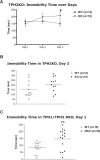Genetic disruption of both tryptophan hydroxylase genes dramatically reduces serotonin and affects behavior in models sensitive to antidepressants
- PMID: 18923670
- PMCID: PMC2565062
- DOI: 10.1371/journal.pone.0003301
Genetic disruption of both tryptophan hydroxylase genes dramatically reduces serotonin and affects behavior in models sensitive to antidepressants
Abstract
The neurotransmitter serotonin (5-HT) plays an important role in both the peripheral and central nervous systems. The biosynthesis of serotonin is regulated by two rate-limiting enzymes, tryptophan hydroxylase-1 and -2 (TPH1 and TPH2). We used a gene-targeting approach to generate mice with selective and complete elimination of the two known TPH isoforms. This resulted in dramatically reduced central 5-HT levels in Tph2 knockout (TPH2KO) and Tph1/Tph2 double knockout (DKO) mice; and substantially reduced peripheral 5-HT levels in DKO, but not TPH2KO mice. Therefore, differential expression of the two isoforms of TPH was reflected in corresponding depletion of 5-HT content in the brain and periphery. Surprisingly, despite the prominent and evolutionarily ancient role that 5-HT plays in both vertebrate and invertebrate physiology, none of these mutations resulted in an overt phenotype. TPH2KO and DKO mice were viable and normal in appearance. Behavioral alterations in assays with predictive validity for antidepressants were among the very few phenotypes uncovered. These behavioral changes were subtle in the TPH2KO mice; they were enhanced in the DKO mice. Herein, we confirm findings from prior descriptions of TPH1 knockout mice and present the first reported phenotypic evaluations of Tph2 and Tph1/Tph2 knockout mice. The behavioral effects observed in the TPH2 KO and DKO mice strongly confirm the role of 5-HT and its synthetic enzymes in the etiology and treatment of affective disorders.
Conflict of interest statement
Figures






Similar articles
-
Brain-specific conditional and time-specific inducible Tph2 knockout mice possess normal serotonergic gene expression in the absence of serotonin during adult life.Neurochem Int. 2010 Nov;57(5):512-7. doi: 10.1016/j.neuint.2010.06.015. Epub 2010 Jul 3. Neurochem Int. 2010. PMID: 20599453
-
Spatio-temporal expression of tryptophan hydroxylase isoforms in murine and human brain: convergent data from Tph2 knockout mice.Eur Neuropsychopharmacol. 2009 Apr;19(4):266-82. doi: 10.1016/j.euroneuro.2008.12.005. Epub 2009 Feb 1. Eur Neuropsychopharmacol. 2009. PMID: 19181488
-
[Abnormal cardiac activity in mice in the absence of peripheral serotonin synthesis].J Soc Biol. 2004;198(1):7-17. J Soc Biol. 2004. PMID: 15146950 Review. French.
-
Late developmental stage-specific role of tryptophan hydroxylase 1 in brain serotonin levels.J Neurosci. 2006 Jan 11;26(2):530-4. doi: 10.1523/JNEUROSCI.1835-05.2006. J Neurosci. 2006. PMID: 16407550 Free PMC article.
-
Knockout mouse points to second form of tryptophan hydroxylase.Mol Interv. 2003 Mar;3(2):72-5, 50. doi: 10.1124/mi.3.2.72. Mol Interv. 2003. PMID: 14993427 Review.
Cited by
-
Mice genetically depleted of brain serotonin display social impairments, communication deficits and repetitive behaviors: possible relevance to autism.PLoS One. 2012;7(11):e48975. doi: 10.1371/journal.pone.0048975. Epub 2012 Nov 6. PLoS One. 2012. PMID: 23139830 Free PMC article.
-
Characterization of PTPRG in knockdown and phosphatase-inactive mutant mice and substrate trapping analysis of PTPRG in mammalian cells.PLoS One. 2012;7(9):e45500. doi: 10.1371/journal.pone.0045500. Epub 2012 Sep 20. PLoS One. 2012. PMID: 23029056 Free PMC article.
-
Genetic depletion of brain 5HT reveals a common molecular pathway mediating compulsivity and impulsivity.J Neurochem. 2012 Jun;121(6):974-84. doi: 10.1111/j.1471-4159.2012.07739.x. Epub 2012 Apr 13. J Neurochem. 2012. PMID: 22443164 Free PMC article.
-
Obstructive Sleep Apnea and Serotoninergic Signalling Pathway: Pathomechanism and Therapeutic Potential.Int J Mol Sci. 2024 Aug 30;25(17):9427. doi: 10.3390/ijms25179427. Int J Mol Sci. 2024. PMID: 39273373 Free PMC article. Review.
-
Examining the blood amino acid status in pretherapeutic patients with hyperphenylalaninemia.J Clin Lab Anal. 2020 Mar;34(3):e23106. doi: 10.1002/jcla.23106. Epub 2019 Nov 24. J Clin Lab Anal. 2020. PMID: 31762087 Free PMC article.
References
-
- Bonasera SJ, Tecott LH. Mouse models of serotonin receptor function: toward a genetic dissection of serotonin systems. Pharmacol Ther. 2000;88:133–142. - PubMed
-
- Buhot MC. Serotonin receptors in cognitive behaviors. Curr Opin Neurobiol. 1997;7:243–254. - PubMed
-
- Ericsson M, Poston WS, 2nd, Foreyt JP. Common biological pathways in eating disorders and obesity. Addict Behav. 1996;21:733–743. - PubMed
-
- Goodman WK. Obsessive-compulsive disorder: diagnosis and treatment. J Clin Psychiatry. 1999;60(Suppl 18):27–32. - PubMed
MeSH terms
Substances
LinkOut - more resources
Full Text Sources
Molecular Biology Databases
Research Materials

